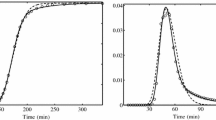Abstract
We deal with a simple model for oxygen transport in alveolar capillaries with exchange of oxygen between the capillaries and alveoli. This model is described by a weakly coupled three-component system of advection-reaction equations in capillaries and a linear diffusion equation in alveoli. We consider the equations in a bounded interval with appropriate boundary conditions. The goal of this article is to show that a steady state solution of the equations is asymptotically stable. To this end we first establish the existence of a unique solution for an initial-boundary value problem of the equations. Then we show the existence of a steady state solution. Finally we prove the main result on the asymptotic stability of the steady state with an exponential convergence rate. The proof can be done by using energy estimates for a large coupling constant.
Similar content being viewed by others
References
Bertsch, M., Hilhorst, D., Izuhara, H., Mimura, M.: A nonlinear parabolic-hyperbolic system for constant inhibition of cell-growth. Differ. Equ. Appl. 4, 137–157 (2012)
Cui, S.: Asymptotic stability of the stationary solution for a parabolic-hyperbolic free boundary problem modeling tumor growth. SIAM J. Math. Anal. 45, 2870–2893 (2013)
Cui, S., Wei, X.: Global existence for a parabolic-hyperbolic free boundary problem modeling tumor growth. Acta Math. Appl. Sin. (English Ser.) 21, 597–614 (2005)
Friedman, A.: Partial Differential Equations of Parabolic Type. Krieger, Malabar (1983)
Hale, J.K.: Ordinary Differential Equations. Krieger, Malabar (1980)
Jimbo, S., Morita, Y.: Lyapunov function and spectrum comparison for a reaction-diffusion system with mass conservation. J. Differ. Equ. 255, 1657–1683 (2013)
John, F.: Partial Differential Equations, 4th edn. Springer, New York (1982)
Keener, J., Sneyd, J.: Mathematical Physiology II: Systems Physiology, 2nd edn. Springer, New York (2009)
Maury, B.: The Respiratory System in Equations, MS&A, vol. 7. Springer, Milan (2013)
Ottesen, J.T., Olufsen, M.S., Larsen, J.K.: Applied Mathematical Models in Human Physiology. Monographs on Mathematical Modeling and Computation. SIAM, Philadelphia (2004)
Smith, H.L.: Monotone Dynamical Systems : An Introduction to the Theory of Competitive and Cooperative Systems. American Mathematical Society, Providence (2008)
Toro, E.F., Siviglia, A.: Simplified blood flow model with discontinuous vessel properties, modeling of physiological flows. In: Ambrosi, D., Quarteroni, A., Rozza, G. (eds.) MS&A, vol. 5, pp. 19–39. Springer, Milan (2012)
Acknowledgments
The authors would like to express their thanks to Professor Masaharu Nagayama for his useful comment on the chemical model for hemoglobin and oxygen. They also would like to thank the referees for useful comments for the revisions. The first author was partially supported by JSPS KAKENHI Grant Number 26287025, 24654044, 26247013.
Author information
Authors and Affiliations
Corresponding author
Appendices
Appendix A: Reaction equations for \(\text{ O }_2\) and \(\text{ Hb }\)
Hemoglobin, a large protein molecule, has four binding sites for oxygen. Although the chemical process between hemoglobin and oxygen is complex, the following simple model is used in [8]:

The corresponding equations by the law of mass action are given by
In fact, consider the percentage of hemoglobin sites which are bound to oxygen
and at the steady state of the equations we have a function depending on the oxygen as
This function qualitatively matches the hemoglobin saturation curve of experimental data. However, the modified function
with \(n=2.5\) fits much better the saturation curve, which is stated in Chap.16 of [8] (see also Chap.5 of [9]).
Hence, we take the model equations in our study as
covering both cases \(n=4\) and \(n=2.5\).
Appendix B: Numerical simulations for the asymptotic behavior
In this section we exhibit numerical experiments which support our main result. Here we only show two typical cases, though we made the simulation for other parameter values. We set parameter values in the Eq. (3) as
the boundary condition
and the initial condition
We assume the Neumann condition for w. Recall the kinetics of the equations allows the equilibrium point
thus we set the value \(u_{in}\) below \(\lambda \) at \(x=0\).
In the upper figure in Fig. 1 we set \(d_1=3.5\) and \(L=3.0\). We can observe time evolution of the u-profile of the solution on the interval [0, L], where the profile of the concentration increases as time goes, eventually, at \(L=3.0\), u is very close to \(\lambda =9\) (the dot line in the figure).
Time evolution of the u profile of the solution of (3) with the parameter values (66), (67) and (68). The vertical axis stands for the concentration u (the oxygen) and the horizontal one is the x-axis. The dot line indicates the level \(\lambda =9.0\). In the numerical result for the case (a) \(d_1=3.5\) and \(L=3.0\) is shown in the upper figure while (b) \(d_1=0.05\) and \(L=170\) in the lower one. In (a) the snap shots for \(t=0, 0.7, 1.4\) and 2.8 are drawn while \(t=0, 40, 80\) and 160 in (b)
On the other hand in the lower figure in Fig. 1 we see the behavior of the solution for the case \(d_1=0.05\) and \(L=170\), a smaller diffusion rate and a longer interval. In order to get close to \(\lambda \) at \(x=L\), a sufficiently long interval is necessary, otherwise the profile of the u-concentration is far below from \(\lambda \) on the whole interval.
The last profile of u in each figure is not visually changed further in time t though we made the simulation. As a conclusion in both cases we can observe the convergence of the solution to an equilibrium state.
About this article
Cite this article
Morita, Y., Shinjo, N. A weakly coupled system of advection-reaction and diffusion equations in physiological gas transport. Japan J. Indust. Appl. Math. 32, 437–463 (2015). https://doi.org/10.1007/s13160-015-0174-8
Received:
Revised:
Published:
Issue Date:
DOI: https://doi.org/10.1007/s13160-015-0174-8




